How Is Fluidity Reduced In Animal Cells
Characteristics of Eukaryotic Cells
A eukaryotic cell has a true membrane-jump nucleus and has other membranous organelles that allow for compartmentalization of functions.
Learning Objectives
Describe the structure of eukaryotic cells
Key Takeaways
Central Points
- Eukaryotic cells are larger than prokaryotic cells and take a "truthful" nucleus, membrane-bound organelles, and rod-shaped chromosomes.
- The nucleus houses the cell's DNA and directs the synthesis of proteins and ribosomes.
- Mitochondria are responsible for ATP production; the endoplasmic reticulum modifies proteins and synthesizes lipids; and the golgi appliance is where the sorting of lipids and proteins takes place.
- Peroxisomes carry out oxidation reactions that suspension down fatty acids and amino acids and detoxify poisons; vesicles and vacuoles function in storage and transport.
- Animal cells have a centrosome and lysosomes while plant cells do not.
- Plant cells accept a cell wall, a large central vacuole, chloroplasts, and other specialized plastids, whereas brute cells do not.
Primal Terms
- eukaryotic: Having circuitous cells in which the genetic material is organized into membrane-bound nuclei.
- organelle: A specialized construction institute inside cells that carries out a specific life process (east.g. ribosomes, vacuoles).
- photosynthesis: the process past which plants and other photoautotrophs generate carbohydrates and oxygen from carbon dioxide, water, and calorie-free energy in chloroplasts
Eukaryotic Cell Structure
Similar a prokaryotic jail cell, a eukaryotic cell has a plasma membrane, cytoplasm, and ribosomes. However, unlike prokaryotic cells, eukaryotic cells have:
- a membrane-bound nucleus
- numerous membrane-bound organelles (including the endoplasmic reticulum, Golgi apparatus, chloroplasts, and mitochondria)
- several rod-shaped chromosomes
Because a eukaryotic prison cell'southward nucleus is surrounded by a membrane, it is often said to have a "true nucleus. " Organelles (meaning "little organ") have specialized cellular roles, merely as the organs of your body take specialized roles. They allow different functions to exist compartmentalized in unlike areas of the cell.
The Nucleus & Its Structures
Typically, the nucleus is the most prominent organelle in a cell. Eukaryotic cells have a true nucleus, which means the cell'southward Deoxyribonucleic acid is surrounded by a membrane. Therefore, the nucleus houses the cell'due south DNA and directs the synthesis of proteins and ribosomes, the cellular organelles responsible for protein synthesis. The nuclear envelope is a double-membrane construction that constitutes the outermost portion of the nucleus. Both the inner and outer membranes of the nuclear envelope are phospholipid bilayers. The nuclear envelope is punctuated with pores that control the passage of ions, molecules, and RNA betwixt the nucleoplasm and cytoplasm. The nucleoplasm is the semi-solid fluid within the nucleus where nosotros find the chromatin and the nucleolus. Furthermore, chromosomes are structures within the nucleus that are made up of Deoxyribonucleic acid, the genetic material. In prokaryotes, Deoxyribonucleic acid is organized into a single round chromosome. In eukaryotes, chromosomes are linear structures.
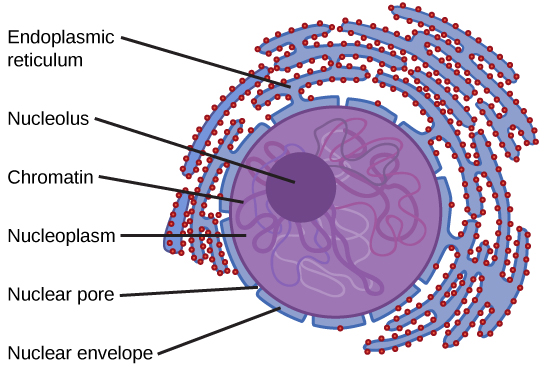
Eukaryotic Nucleus: The nucleus stores chromatin (Dna plus proteins) in a gel-like substance called the nucleoplasm.The nucleolus is a condensed region of chromatin where ribosome synthesis occurs.The boundary of the nucleus is called the nuclear envelope.It consists of two phospholipid bilayers: an outer membrane and an inner membrane.The nuclear membrane is continuous with the endoplasmic reticulum.Nuclear pores let substances to enter and exit the nucleus.
Other Membrane-Bound Organelles
Mitochondria are oval-shaped, double membrane organelles that accept their own ribosomes and Dna. These organelles are often called the "energy factories" of a cell because they are responsible for making adenosine triphosphate (ATP), the jail cell'due south main energy-carrying molecule, by conducting cellular respiration. The endoplasmic reticulum modifies proteins and synthesizes lipids, while the golgi apparatus is where the sorting, tagging, packaging, and distribution of lipids and proteins takes place. Peroxisomes are small, round organelles enclosed by unmarried membranes; they deport out oxidation reactions that break downwardly fatty acids and amino acids. Peroxisomes as well detoxify many poisons that may enter the body. Vesicles and vacuoles are membrane-bound sacs that function in storage and transport. Other than the fact that vacuoles are somewhat larger than vesicles, there is a very subtle distinction betwixt them: the membranes of vesicles can fuse with either the plasma membrane or other membrane systems within the jail cell. All of these organelles are found in each and every eukaryotic prison cell.
Brute Cells Versus Plant Cells
While all eukaryotic cells comprise the aforementioned organelles and structures, there are some striking differences between animal and found cells. Animal cells take a centrosome and lysosomes, whereas establish cells do not. The centrosome is a microtubule-organizing centre found near the nuclei of animal cells while lysosomes take care of the prison cell's digestive process.
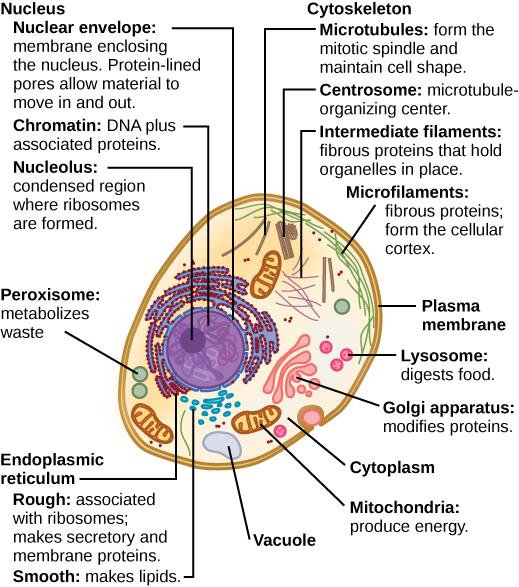
Animal Cells: Despite their fundamental similarities, there are some hit differences between animal and plant cells.Animal cells have centrioles, centrosomes, and lysosomes, whereas plant cells exercise not.
In add-on, plant cells have a cell wall, a large central vacuole, chloroplasts, and other specialized plastids, whereas creature cells practise non. The prison cell wall protects the cell, provides structural support, and gives shape to the prison cell while the cardinal vacuole plays a cardinal role in regulating the cell's concentration of water in changing environmental conditions. Chloroplasts are the organelles that conduct out photosynthesis.
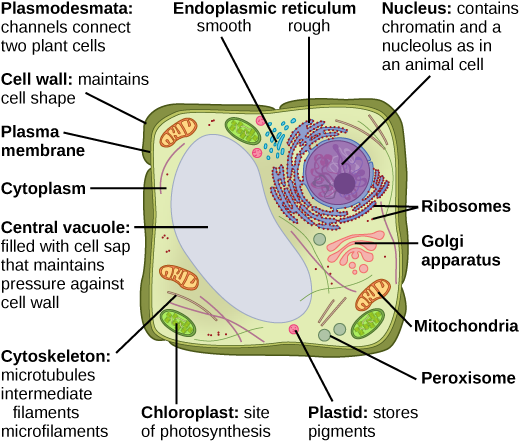
Plant Cells: Found cells accept a cell wall, chloroplasts, plasmodesmata, and plastids used for storage, and a large central vacuole, whereas brute cells do not.
The Plasma Membrane and the Cytoplasm
The plasma membrane is fabricated up of a phospholipid bilayer that regulates the concentration of substances that can permeate a cell.
Learning Objectives
Explain the structure and purpose of the plasma membrane of a prison cell
Key Takeaways
Key Points
- All eukaryotic cells take a surrounding plasma membrane, which is likewise known every bit the cell membrane.
- The plasma membrane is made up by a phospholipid bilayer with embedded proteins that separates the internal contents of the cell from its surrounding surround.
- Simply relatively pocket-size, non- polar materials tin can hands motion through the lipid bilayer of the plasma membrane.
- Passive transport is the motion of substances across the membrane that does not require the use of energy while active transport is the movement of substances across the membrane using energy.
- Osmosis is the diffusion of water through a semi- permeable membrane down its concentration slope; this occurs when in that location is an imbalance of solutes exterior of a jail cell compared to the inside the cell.
Key Terms
- phospholipid: Whatsoever lipid consisting of a diglyceride combined with a phosphate group and a simple organic molecule such every bit choline or ethanolamine; they are important constituents of biological membranes
- hypertonic: having a greater osmotic pressure than another
- hypotonic: Having a lower osmotic force per unit area than another; a cell in this environment causes water to enter the prison cell, causing it to not bad.
The Plasma Membrane
Despite differences in structure and function, all living cells in multicellular organisms have a surrounding plasma membrane (likewise known equally the jail cell membrane). As the outer layer of your pare separates your trunk from its surroundings, the plasma membrane separates the inner contents of a cell from its outside environment. The plasma membrane can be described every bit a phospholipid bilayer with embedded proteins that controls the passage of organic molecules, ions, water, and oxygen into and out of the cell. Wastes (such as carbon dioxide and ammonia) also leave the cell past passing through the membrane.
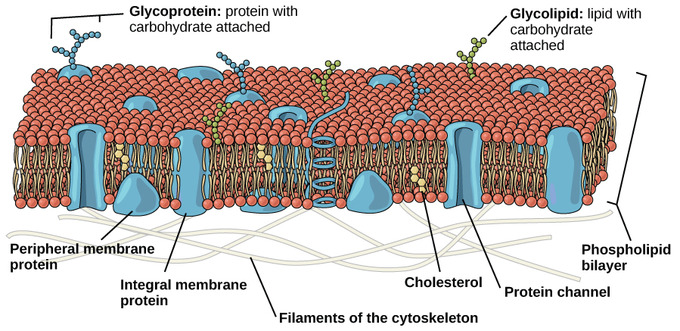
Eukaryotic Plasma Membrane: The eukaryotic plasma membrane is a phospholipid bilayer with proteins and cholesterol embedded in it.
The prison cell membrane is an extremely pliable structure composed primarily of 2 adjacent sheets of phospholipids. Cholesterol, also present, contributes to the fluidity of the membrane. A single phospholipid molecule consists of a polar phosphate "head," which is hydrophilic, and a non-polar lipid "tail," which is hydrophobic. Unsaturated fatty acids result in kinks in the hydrophobic tails. The phospholipid bilayer consists of two phospholipids arranged tail to tail. The hydrophobic tails associate with ane another, forming the interior of the membrane. The polar heads contact the fluid inside and outside of the cell.
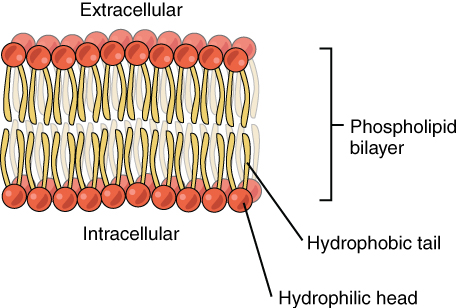
Phospholipid Bilayer: The phospholipid bilayer consists of 2 adjacent sheets of phospholipids, arranged tail to tail. The hydrophobic tails associate with ane another, forming the interior of the membrane. The polar heads contact the fluid inside and exterior of the jail cell.
The plasma membrane's principal function is to regulate the concentration of substances inside the cell. These substances include ions such equally Ca++, Na+, 1000+, and Cl–; nutrients including sugars, fatty acids, and amino acids; and waste material products, peculiarly carbon dioxide (COtwo), which must leave the cell.
The membrane'south lipid bilayer construction provides the cell with access control through permeability. The phospholipids are tightly packed together, while the membrane has a hydrophobic interior. This structure causes the membrane to exist selectively permeable. A membrane that has selective permeability allows only substances coming together certain criteria to laissez passer through information technology unaided. In the case of the plasma membrane, just relatively pocket-size, non-polar materials can motility through the lipid bilayer (remember, the lipid tails of the membrane are nonpolar). Some examples of these materials are other lipids, oxygen and carbon dioxide gases, and alcohol. However, h2o-soluble materials—such as glucose, amino acids, and electrolytes—need some help to cantankerous the membrane considering they are repelled by the hydrophobic tails of the phospholipid bilayer.
Send Across the Membrane
All substances that move through the membrane practice and so by one of two full general methods, which are categorized based on whether or non free energy is required. Passive (non-energy requiring) transport is the movement of substances beyond the membrane without the expenditure of cellular energy. During this type of ship, materials move by elementary diffusion or by facilitated improvidence through the membrane, downwardly their concentration gradient. Water passes through the membrane in a improvidence process called osmosis. Osmosis is the diffusion of h2o through a semi-permeable membrane downward its concentration slope. It occurs when there is an imbalance of solutes exterior of a cell versus within the cell. The solution that has the higher concentration of solutes is said to exist hypertonic and the solution that has the lower concentration of solutes is said to be hypotonic. Water molecules will diffuse out of the hypotonic solution and into the hypertonic solution (unless acted upon by hydrostatic forces).
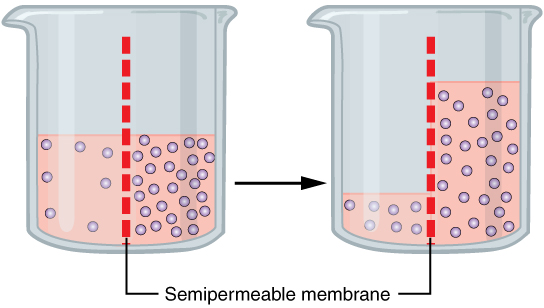
Osmosis: Osmosis is the improvidence of water through a semipermeable membrane downward its concentration slope. If a membrane is permeable to h2o, though not to a solute, water will equalize its own concentration by diffusing to the side of lower water concentration (and thus the side of higher solute concentration). In the chalice on the left, the solution on the right side of the membrane is hypertonic.
In contrast to passive transport, active (free energy-requiring) transport is the movement of substances across the membrane using energy from adenosine triphosphate (ATP). The free energy is expended to assist material move across the membrane in a direction against their concentration slope. Agile send may take place with the assistance of poly peptide pumps or through the apply of vesicles. Another form of this type of transport is endocytosis, where a cell envelopes extracellular materials using its cell membrane. The opposite process is known as exocytosis. This is where a jail cell exports cloth using vesicular ship.
Cytoplasm
The cell'southward plasma membrane also helps contain the cell's cytoplasm, which provides a gel-like environment for the cell's organelles. The cytoplasm is the location for most cellular processes, including metabolism, protein folding, and internal transportation.
The Nucleus and Ribosomes
Establish within eukaryotic cells, the nucleus contains the genetic cloth that determines the entire structure and function of that prison cell.
Learning Objectives
Explicate the purpose of the nucleus in eukaryotic cells
Primal Takeaways
Key Points
- The nucleus contains the cell 's DNA and directs the synthesis of ribosomes and proteins.
- Found within the nucleoplasm, the nucleolus is a condensed region of chromatin where ribosome synthesis occurs.
- Chromatin consists of DNA wrapped around histone proteins and is stored inside the nucleoplasm.
- Ribosomes are large complexes of poly peptide and ribonucleic acid (RNA) responsible for poly peptide synthesis when Dna from the nucleus is transcribed.
Central Terms
- histone: whatsoever of various elementary water-soluble proteins that are rich in the basic amino acids lysine and arginine and are complexed with Deoxyribonucleic acid in the nucleosomes of eukaryotic chromatin
- nucleolus: a conspicuous, rounded, non-membrane jump body within the nucleus of a cell
- chromatin: a complex of Deoxyribonucleic acid, RNA, and proteins within the cell nucleus out of which chromosomes condense during cell sectionalization
The Nucleus
One of the master differences betwixt prokaryotic and eukaryotic cells is the nucleus. As previously discussed, prokaryotic cells lack an organized nucleus while eukaryotic cells contain membrane-bound nuclei (and organelles ) that house the cell'due south DNA and direct the synthesis of ribosomes and proteins.
The nucleus stores chromatin (Deoxyribonucleic acid plus proteins) in a gel-like substance called the nucleoplasm. To understand chromatin, information technology is helpful to first consider chromosomes. Chromatin describes the material that makes up chromosomes, which are structures inside the nucleus that are made upwardly of DNA, the hereditary material. You may call up that in prokaryotes, Dna is organized into a single circular chromosome. In eukaryotes, chromosomes are linear structures. Every eukaryotic species has a specific number of chromosomes in the nuclei of its trunk's cells. For example, in humans, the chromosome number is 46, while in fruit flies, information technology is eight. Chromosomes are only visible and distinguishable from one another when the cell is getting ready to divide. In gild to organize the large corporeality of Deoxyribonucleic acid within the nucleus, proteins called histones are attached to chromosomes; the Dna is wrapped around these histones to form a structure resembling beads on a string. These protein-chromosome complexes are chosen chromatin.
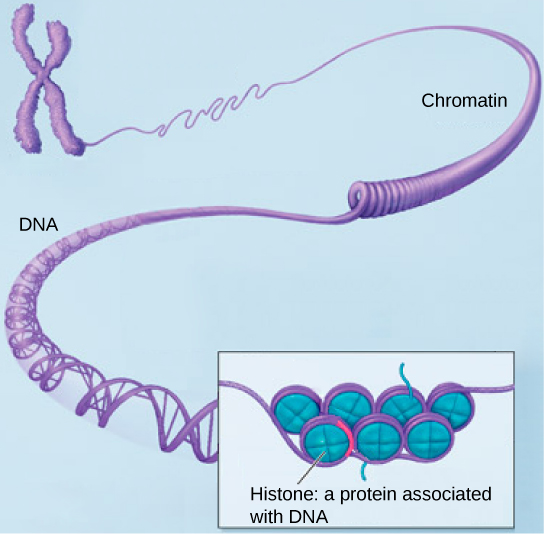
DNA is highly organized: This epitome shows various levels of the organisation of chromatin (Deoxyribonucleic acid and poly peptide). Forth the chromatin threads, unwound poly peptide-chromosome complexes, we observe DNA wrapped around a set of histone proteins.
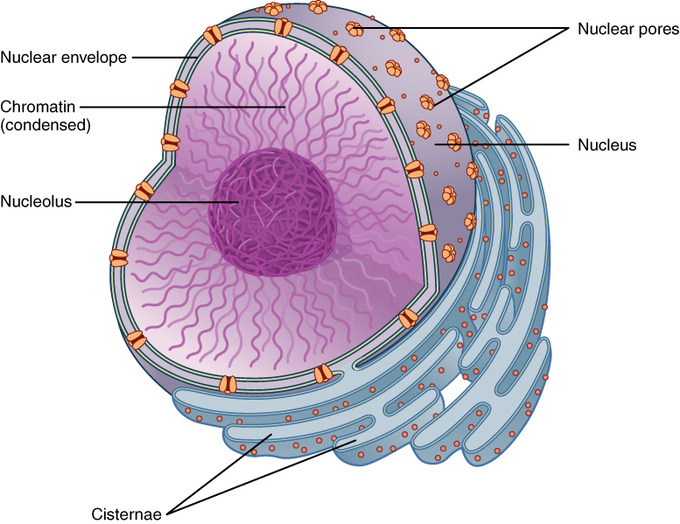
The nucleus stores the hereditary material of the cell: The nucleus is the control center of the prison cell. The nucleus of living cells contains the genetic material that determines the unabridged structure and function of that cell.
The nucleoplasm is also where we find the nucleolus. The nucleolus is a condensed region of chromatin where ribosome synthesis occurs. Ribosomes, big complexes of protein and ribonucleic acid (RNA), are the cellular organelles responsible for protein synthesis. They receive their "orders" for protein synthesis from the nucleus where the Dna is transcribed into messenger RNA (mRNA). This mRNA travels to the ribosomes, which interpret the code provided past the sequence of the nitrogenous bases in the mRNA into a specific society of amino acids in a protein.
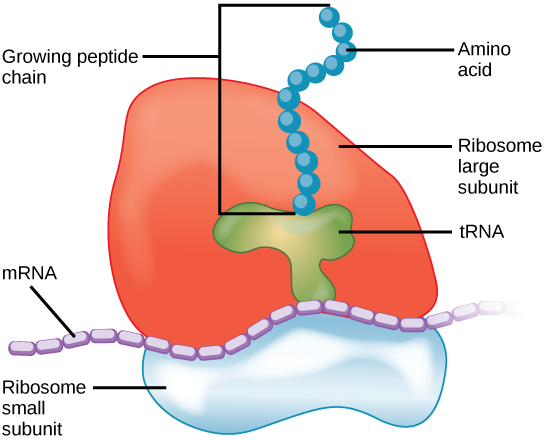
Ribosomes are responsible for protein synthesis: Ribosomes are made up of a large subunit (acme) and a pocket-size subunit (bottom). During protein synthesis, ribosomes get together amino acids into proteins.
Lastly, the boundary of the nucleus is called the nuclear envelope. Information technology consists of two phospholipid bilayers: an outer membrane and an inner membrane. The nuclear membrane is continuous with the endoplasmic reticulum, while nuclear pores allow substances to enter and get out the nucleus.
Mitochondria
Mitochondria are organelles that are responsible for making adenosine triphosphate (ATP), the prison cell's main energy-carrying molecule.
Learning Objectives
Explain the role of the mitochondria.
Central Takeaways
Key Points
- Mitochondria comprise their ain ribosomes and DNA; combined with their double membrane, these features suggest that they might have once been gratuitous-living prokaryotes that were engulfed by a larger cell.
- Mitochondria have an important function in cellular respiration through the product of ATP, using chemical energy found in glucose and other nutrients.
- Mitochondria are likewise responsible for generating clusters of iron and sulfur, which are of import cofactors of many enzymes.
Key Terms
- alpha-proteobacteria: A taxonomic form within the phylum Proteobacteria — the phototropic proteobacteria.
- adenosine triphosphate: a multifunctional nucleoside triphosphate used in cells as a coenzyme, often chosen the "molecular unit of energy currency" in intracellular free energy transfer
- cofactor: an inorganic molecule that is necessary for an enzyme to function
One of the major features distinguishing prokaryotes from eukaryotes is the presence of mitochondria. Mitochondria are double-membraned organelles that comprise their own ribosomes and Deoxyribonucleic acid. Each membrane is a phospholipid bilayer embedded with proteins. Eukaryotic cells may comprise anywhere from one to several thousand mitochondria, depending on the prison cell'south level of free energy consumption. Each mitochondrion measures one to 10 micrometers (or greater) in length and exists in the prison cell as an organelle that can be ovoid to worm-shaped to intricately branched.
Mitochondria Structure
Nearly mitochondria are surrounded by two membranes, which would result when ane membrane-spring organism was engulfed into a vacuole by another membrane-spring organism. The mitochondrial inner membrane is extensive and involves substantial infoldings called cristae that resemble the textured, outer surface of alpha-proteobacteria. The matrix and inner membrane are rich with the enzymes necessary for aerobic respiration.
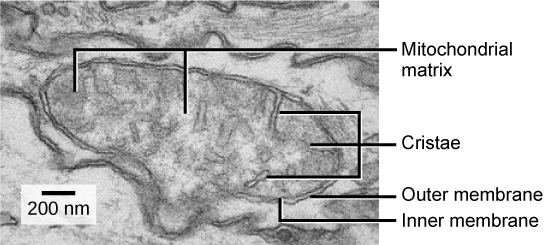
Mitochondrial structure: This electron micrograph shows a mitochondrion equally viewed with a transmission electron microscope. This organelle has an outer membrane and an inner membrane. The inner membrane contains folds, chosen cristae, which increase its surface expanse. The space between the 2 membranes is called the intermembrane infinite, and the space within the inner membrane is called the mitochondrial matrix. ATP synthesis takes place on the inner membrane.
Mitochondria have their own (usually) round DNA chromosome that is stabilized past attachments to the inner membrane and carries genes similar to genes expressed by alpha-proteobacteria. Mitochondria too accept special ribosomes and transfer RNAs that resemble these components in prokaryotes. These features all back up the hypothesis that mitochondria were one time costless-living prokaryotes.
Mitochondria Function
Mitochondria are ofttimes called the "powerhouses" or "free energy factories" of a cell because they are responsible for making adenosine triphosphate (ATP), the jail cell's principal energy-carrying molecule. ATP represents the short-term stored energy of the cell. Cellular respiration is the process of making ATP using the chemic energy found in glucose and other nutrients. In mitochondria, this process uses oxygen and produces carbon dioxide equally a waste product production. In fact, the carbon dioxide that yous exhale with every breath comes from the cellular reactions that produce carbon dioxide equally a past-product.
It is important to bespeak out that muscle cells accept a very high concentration of mitochondria that produce ATP. Your muscle cells need a lot of free energy to keep your torso moving. When your cells don't get enough oxygen, they do not make a lot of ATP. Instead, the small corporeality of ATP they make in the absence of oxygen is accompanied by the production of lactic acid.
In addition to the aerobic generation of ATP, mitochondria have several other metabolic functions. One of these functions is to generate clusters of iron and sulfur that are important cofactors of many enzymes. Such functions are often associated with the reduced mitochondrion-derived organelles of anaerobic eukaryotes.
Origins of Mitochondria
There are ii hypotheses about the origin of mitochondria: endosymbiotic and autogenous, simply the most accredited theory at present is endosymbiosis. The endosymbiotic hypothesis suggests mitochondria were originally prokaryotic cells, capable of implementing oxidative mechanisms. These prokaryotic cells may have been engulfed by a eukaryote and became endosymbionts living inside the eukaryote.
Comparing Plant and Animal Cells
Although they are both eukaryotic cells, there are unique structural differences between brute and plant cells.
Learning Objectives
Differentiate betwixt the structures found in animal and plant cells
Key Takeaways
Key Points
- Centrosomes and lysosomes are institute in fauna cells, but do not exist within plant cells.
- The lysosomes are the animal cell's "garbage disposal", while in found cells the same function takes place in vacuoles.
- Plant cells have a cell wall, chloroplasts and other specialized plastids, and a large central vacuole, which are not constitute within animal cells.
- The prison cell wall is a rigid covering that protects the jail cell, provides structural back up, and gives shape to the jail cell.
- The chloroplasts, found in plant cells, incorporate a light-green pigment called chlorophyll, which captures the light free energy that drives the reactions of plant photosynthesis.
- The primal vacuole plays a fundamental role in regulating a constitute prison cell's concentration of water in changing environmental conditions.
Primal Terms
- protist: Any of the eukaryotic unicellular organisms including protozoans, slime molds and some algae; historically grouped into the kingdom Protoctista.
- autotroph: Any organism that tin can synthesize its nutrient from inorganic substances, using rut or light as a source of energy
- heterotroph: an organism that requires an external supply of energy in the grade of nutrient, as it cannot synthesize its own
Animal Cells versus Plant Cells
Each eukaryotic cell has a plasma membrane, cytoplasm, a nucleus, ribosomes, mitochondria, peroxisomes, and in some, vacuoles; nonetheless, at that place are some striking differences betwixt fauna and plant cells. While both animate being and plant cells have microtubule organizing centers (MTOCs), animal cells also have centrioles associated with the MTOC: a circuitous called the centrosome. Creature cells each accept a centrosome and lysosomes, whereas establish cells practise not. Plant cells have a prison cell wall, chloroplasts and other specialized plastids, and a large key vacuole, whereas beast cells do not.
The Centrosome
The centrosome is a microtubule-organizing center found nearly the nuclei of fauna cells. Information technology contains a pair of centrioles, 2 structures that lie perpendicular to each other. Each centriole is a cylinder of nine triplets of microtubules. The centrosome (the organelle where all microtubules originate) replicates itself earlier a cell divides, and the centrioles announced to take some role in pulling the duplicated chromosomes to opposite ends of the dividing cell. However, the exact function of the centrioles in prison cell sectionalization isn't clear, because cells that have had the centrosome removed tin still divide; and establish cells, which lack centrosomes, are capable of cell partition.
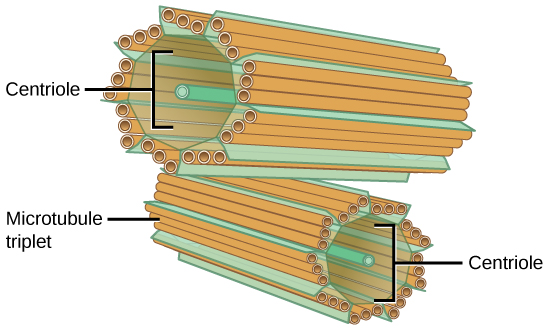
The Centrosome Structure: The centrosome consists of 2 centrioles that lie at right angles to each other. Each centriole is a cylinder made upward of ix triplets of microtubules. Nontubulin proteins (indicated by the green lines) hold the microtubule triplets together.
Lysosomes
Animate being cells have another set of organelles non establish in constitute cells: lysosomes. The lysosomes are the cell's "garbage disposal." In plant cells, the digestive processes take place in vacuoles. Enzymes within the lysosomes aid the breakdown of proteins, polysaccharides, lipids, nucleic acids, and fifty-fifty worn-out organelles. These enzymes are agile at a much lower pH than that of the cytoplasm. Therefore, the pH within lysosomes is more acidic than the pH of the cytoplasm. Many reactions that take place in the cytoplasm could not occur at a low pH, so the advantage of compartmentalizing the eukaryotic cell into organelles is apparent.
The Cell Wall
The jail cell wall is a rigid covering that protects the prison cell, provides structural support, and gives shape to the cell. Fungal and protistan cells also accept cell walls. While the principal component of prokaryotic cell walls is peptidoglycan, the major organic molecule in the plant prison cell wall is cellulose, a polysaccharide comprised of glucose units. When you bite into a raw vegetable, like celery, information technology crunches. That'southward because yous are violent the rigid jail cell walls of the celery cells with your teeth.

Cellulose: Cellulose is a long chain of β-glucose molecules connected by a 1-iv linkage. The dashed lines at each end of the figure bespeak a series of many more glucose units. The size of the folio makes information technology impossible to portray an entire cellulose molecule.
Chloroplasts
Like mitochondria, chloroplasts take their own Dna and ribosomes, just chloroplasts have an entirely unlike function. Chloroplasts are plant cell organelles that carry out photosynthesis. Photosynthesis is the series of reactions that utilize carbon dioxide, water, and low-cal energy to make glucose and oxygen. This is a major difference between plants and animals; plants (autotrophs) are able to brand their ain food, like sugars, while animals (heterotrophs) must ingest their nutrient.
Like mitochondria, chloroplasts have outer and inner membranes, but within the space enclosed by a chloroplast's inner membrane is a fix of interconnected and stacked fluid-filled membrane sacs called thylakoids. Each stack of thylakoids is chosen a granum (plural = grana). The fluid enclosed past the inner membrane that surrounds the grana is called the stroma.
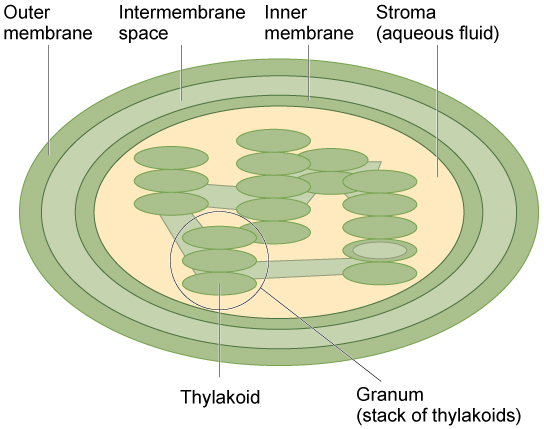
The Chloroplast Construction: The chloroplast has an outer membrane, an inner membrane, and membrane structures called thylakoids that are stacked into grana. The space within the thylakoid membranes is called the thylakoid space. The calorie-free harvesting reactions take place in the thylakoid membranes, and the synthesis of carbohydrate takes place in the fluid inside the inner membrane, which is called the stroma.
The chloroplasts contain a green pigment called chlorophyll, which captures the light energy that drives the reactions of photosynthesis. Like found cells, photosynthetic protists as well have chloroplasts. Some bacteria perform photosynthesis, but their chlorophyll is not relegated to an organelle.
The Central Vacuole
The central vacuole plays a fundamental part in regulating the prison cell's concentration of water in irresolute environmental conditions. When you forget to water a plant for a few days, it wilts. That'due south because as the water concentration in the soil becomes lower than the water concentration in the plant, h2o moves out of the central vacuoles and cytoplasm. Equally the fundamental vacuole shrinks, information technology leaves the jail cell wall unsupported. This loss of support to the jail cell walls of plant cells results in the wilted appearance of the found. The central vacuole also supports the expansion of the cell. When the central vacuole holds more water, the cell gets larger without having to invest a lot of energy in synthesizing new cytoplasm.
Licenses and Attributions
CC licensed content, Shared previously
- Curation and Revision. Provided by: Dizzying.com. License: CC BY-SA: Attribution-ShareAlike
CC licensed content, Specific attribution
- OpenStax Higher, Biology. October 16, 2013. Provided by: OpenStax CNX. Located at: https://openstax.org/books/biology/pages/iv-3-eukaryotic-cells. License: CC Past: Attribution
- OpenStax Higher, Eukaryotic Cells. October 22, 2013. Provided by: OpenStax CNX. License: CC Past: Attribution
- organelle. Provided by: Wiktionary. Located at: https://en.wiktionary.org/wiki/organelle. License: CC Past-SA: Attribution-ShareAlike
- photosynthesis. Provided by: Wiktionary. License: CC BY-SA: Attribution-ShareAlike
- eukaryotic. Provided by: Wiktionary. License: CC BY-SA: Attribution-ShareAlike
- OpenStax College, Eukaryotic Cells. October 22, 2013. Provided by: OpenStax CNX. Located at: https://cnx.org/contents/[electronic mail protected]. License: CC By: Attribution
- OpenStax College, Eukaryotic Cells. Oct xvi, 2013. Provided by: OpenStax CNX. License: CC BY: Attribution
- OpenStax College, Eukaryotic Cells. October 22, 2013. Provided by: OpenStax CNX. Located at: https://cnx.org/contents/[email protected]. License: CC By: Attribution
- OpenStax College, Biology. October 16, 2013. Provided by: OpenStax CNX. License: CC BY: Attribution
- Laura Martin, Discovering the Structure of the Plasma Membrane. Oct 23, 2013. Provided by: OpenStax CNX. Located at: https://cnx.org/contents/[email protected]. License: CC BY: Attribution
- phospholipid. Provided by: Wiktionary. Located at: https://en.wiktionary.org/wiki/phospholipid. License: CC BY-SA: Attribution-ShareAlike
- hypertonic. Provided by: Wiktionary. License: CC BY-SA: Attribution-ShareAlike
- hypotonic. Provided past: Wiktionary. License: CC BY-SA: Attribution-ShareAlike
- OpenStax College, Eukaryotic Cells. October 22, 2013. Provided by: OpenStax CNX. Located at: https://cnx.org/contents/[email protected]. License: CC By: Attribution
- OpenStax College, Eukaryotic Cells. Oct 16, 2013. Provided by: OpenStax CNX. License: CC BY: Attribution
- OpenStax College, Eukaryotic Cells. October 22, 2013. Provided by: OpenStax CNX. Located at: https://cnx.org/contents/[email protected]. License: CC BY: Attribution
- OpenStax College, Eukaryotic Cells. Oct xvi, 2013. Provided by: OpenStax CNX. License: CC BY: Attribution
- OpenStax Higher, The Prison cell Membrane. October 23, 2013. Provided by: OpenStax CNX. Located at: https://cnx.org/contents/[email protected]. License: CC BY: Attribution
- OpenStax Higher, The Cell Membrane. Oct 23, 2013. Provided by: OpenStax CNX. License: CC BY: Attribution
- OpenStax Higher, Biology. October sixteen, 2013. Provided past: OpenStax CNX. Located at: https://openstax.org/books/biological science/pages/4-3-eukaryotic-cells. License: CC Past: Attribution
- OpenStax College, Biology. Oct 21, 2013. Provided past: OpenStax CNX. License: CC BY: Attribution
- histone. Provided by: Wiktionary. Located at: https://en.wiktionary.org/wiki/histone. License: CC Past-SA: Attribution-ShareAlike
- chromatin. Provided by: Wiktionary. License: CC BY-SA: Attribution-ShareAlike
- Boundless. Provided by: Boundless Learning. License: CC BY-SA: Attribution-ShareAlike
- OpenStax Higher, Eukaryotic Cells. October 22, 2013. Provided by: OpenStax CNX. Located at: https://cnx.org/contents/[email protected]. License: CC By: Attribution
- OpenStax College, Eukaryotic Cells. October 16, 2013. Provided by: OpenStax CNX. License: CC By: Attribution
- OpenStax Higher, Eukaryotic Cells. October 22, 2013. Provided by: OpenStax CNX. Located at: https://cnx.org/contents/[email protected]. License: CC Past: Attribution
- OpenStax College, Eukaryotic Cells. Oct 16, 2013. Provided by: OpenStax CNX. License: CC BY: Attribution
- OpenStax Higher, The Cell Membrane. October 23, 2013. Provided by: OpenStax CNX. Located at: https://cnx.org/contents/[email protected]. License: CC Past: Attribution
- OpenStax College, The Prison cell Membrane. October 23, 2013. Provided by: OpenStax CNX. License: CC Past: Attribution
- OpenStax College, Biology. October 23, 2013. Provided past: OpenStax CNX. Located at: https://openstax.org/books/biology/pages/4-3-eukaryotic-cells. License: CC BY: Attribution
- OpenStax College, The Nucleus and Deoxyribonucleic acid Replication. October 23, 2013. Provided by: OpenStax CNX. License: CC BY: Attribution
- OpenStax College, Biology. October 23, 2013. Provided by: OpenStax CNX. Located at: https://openstax.org/books/biology/pages/iv-three-eukaryotic-cells. License: CC By: Attribution
- OpenStax College, Biology. October xvi, 2013. Provided by: OpenStax CNX. License: CC By: Attribution
- OpenStax College, Eukaryotic Origins. Oct 22, 2013. Provided past: OpenStax CNX. Located at: https://cnx.org/contents/[email protected]. License: CC BY: Attribution
- cofactor. Provided past: Wiktionary. Located at: https://en.wiktionary.org/wiki/cofactor. License: CC By-SA: Attribution-ShareAlike
- adenosine triphosphate. Provided by: Wikipedia. Located at: https://en.wikipedia.org/wiki/Adenosine_triphosphate. License: CC By-SA: Attribution-ShareAlike
- alpha-proteobacteria. Provided by: Wikipedia. License: CC By-SA: Attribution-ShareAlike
- Mitochondrion. Provided past: Wikipedia. License: CC By-SA: Attribution-ShareAlike
- OpenStax College, Eukaryotic Cells. October 22, 2013. Provided past: OpenStax CNX. Located at: https://cnx.org/contents/[e-mail protected]. License: CC BY: Attribution
- OpenStax College, Eukaryotic Cells. October 16, 2013. Provided by: OpenStax CNX. License: CC By: Attribution
- OpenStax College, Eukaryotic Cells. October 22, 2013. Provided past: OpenStax CNX. Located at: https://cnx.org/contents/[e-mail protected]. License: CC Past: Attribution
- OpenStax College, Eukaryotic Cells. October 16, 2013. Provided by: OpenStax CNX. License: CC BY: Attribution
- OpenStax College, The Cell Membrane. October 23, 2013. Provided by: OpenStax CNX. Located at: https://cnx.org/contents/[electronic mail protected]. License: CC Past: Attribution
- OpenStax College, The Cell Membrane. Oct 23, 2013. Provided by: OpenStax CNX. License: CC By: Attribution
- OpenStax College, Biology. October 23, 2013. Provided past: OpenStax CNX. Located at: https://openstax.org/books/biology/pages/iv-3-eukaryotic-cells. License: CC By: Attribution
- OpenStax College, The Nucleus and Deoxyribonucleic acid Replication. October 23, 2013. Provided by: OpenStax CNX. License: CC BY: Attribution
- OpenStax College, Biology. October 23, 2013. Provided by: OpenStax CNX. Located at: https://openstax.org/books/biology/pages/four-3-eukaryotic-cells. License: CC BY: Attribution
- OpenStax Higher, Eukaryotic Cells. Oct 16, 2013. Provided past: OpenStax CNX. License: CC Past: Attribution
- OpenStax College, Biology. Oct xvi, 2013. Provided by: OpenStax CNX. Located at: https://openstax.org/books/biology/pages/4-3-eukaryotic-cells. License: CC BY: Attribution
- protist. Provided by: Wiktionary. Located at: https://en.wiktionary.org/wiki/protist. License: CC BY-SA: Attribution-ShareAlike
- heterotroph. Provided past: Wiktionary. Located at: https://en.wiktionary.org/wiki/heterotroph. License: CC BY-SA: Attribution-ShareAlike
- autotroph. Provided past: Wiktionary. License: CC By-SA: Attribution-ShareAlike
- OpenStax College, Eukaryotic Cells. October 22, 2013. Provided past: OpenStax CNX. Located at: https://cnx.org/contents/[email protected]. License: CC BY: Attribution
- OpenStax College, Eukaryotic Cells. October xvi, 2013. Provided past: OpenStax CNX. License: CC BY: Attribution
- OpenStax College, Eukaryotic Cells. October 22, 2013. Provided by: OpenStax CNX. Located at: https://cnx.org/contents/[email protected]. License: CC BY: Attribution
- OpenStax College, Eukaryotic Cells. October 16, 2013. Provided by: OpenStax CNX. License: CC BY: Attribution
- OpenStax College, The Cell Membrane. October 23, 2013. Provided by: OpenStax CNX. Located at: https://cnx.org/contents/[email protected]. License: CC Past: Attribution
- OpenStax College, The Cell Membrane. October 23, 2013. Provided by: OpenStax CNX. License: CC Past: Attribution
- OpenStax College, Biology. October 23, 2013. Provided by: OpenStax CNX. Located at: https://openstax.org/books/biology/pages/4-3-eukaryotic-cells. License: CC BY: Attribution
- OpenStax College, The Nucleus and Dna Replication. October 23, 2013. Provided by: OpenStax CNX. License: CC BY: Attribution
- OpenStax College, Biology. October 23, 2013. Provided past: OpenStax CNX. Located at: https://openstax.org/books/biology/pages/4-3-eukaryotic-cells. License: CC By: Attribution
- OpenStax College, Eukaryotic Cells. October xvi, 2013. Provided by: OpenStax CNX. License: CC BY: Attribution
- OpenStax College, Eukaryotic Cells. Oct xvi, 2013. Provided by: OpenStax CNX. Located at: https://cnx.org/resource/6c471fc07b93f95e37e74932a0d859c5561df94b/Figure_04_03_08.jpg. License: CC BY: Attribution
- OpenStax Higher, Eukaryotic Cells. October 16, 2013. Provided by: OpenStax CNX. Located at: https://cnx.org/resources/0e7712c6240a56b256c4573381256187248b3cc6/Figure_04_03_10.jpg. License: CC By: Attribution
- OpenStax College, Eukaryotic Cells. October 16, 2013. Provided by: OpenStax CNX. Located at: https://cnx.org/resources/8d7863d89a8e434e8c28518ade3ccc6e5d59a960/Figure_04_03_09.jpg. License: CC Past: Attribution
Source: https://www.coursehero.com/study-guides/boundless-biology/eukaryotic-cells/
Posted by: moorekrounist.blogspot.com

0 Response to "How Is Fluidity Reduced In Animal Cells"
Post a Comment